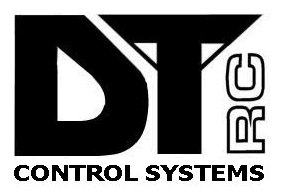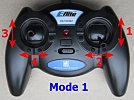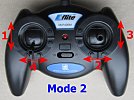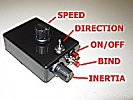

|
Rx62-2 Instructions (v610)
|

|

|

|

|
1. DEFAULT SETUP
|
Item |
Setting | Details |
|
Purpose: |
Rx62-2 |
Train with Tx21 transmitter |
|
Red wire positive (+) Black wire negative (-) |
Battery |
3-13v Observe polarities |
|
eSwitch |
See below. |
|
|
H1 output Brown wires |
Motor Speed knob (Ch1) |
Integrated forward/reverse ESC for brushed motors Center off |
|
P1 output |
Servo Bind button (Ch5) |
'Toggle' servo for coupling Press and release bind button to open/close coupling Servo may need separate 4-6v power supply (UBEC) |
|
P2 output |
Front Light (auto) |
Led needs current limiting resistor LED2 feature |
|
P3 output |
Rear Light (auto) |
Led needs current limiting resistor |
|
P4 output |
IR4 |
Battery voltage telemetry Infrared led needs current limiting resistor |
|
L input |
Auto-detect |
Monitors single cell lipo when used with a voltage booster |
|
Arming: |
Enabled |
Motor control knob to center position (off) |
| LVC | Enabled |
LVC=Low Voltage Cutoff Led 5-flash if triggered Stop and charge battery |
| Inactivity Sleep | Enabled |
Invoked after 1hour Switch off and on to restart |
2. eSWITCH
The eSwitch is an integrated electronic on/off switch. It is optional and can be bypassed (see below).
The eSwitch includes an on-board reed switch which is operated with a magnet. A magnet is not supplied.
Any magnet can be used but the strength required depends on the distance between the magnet and reed.
To switch the receiver ON the magnet must activate the reed switch for any length of time. The led will start working.
To switch the receiver OFF:
1. Press the Bind button for more than 5 seconds. The 5s duration can be adjusted from 1-10s.
2. Alternatively, activate the reed switch with a magnet for more than 2 seconds. To reduce false triggering, the receiver will switch itself off 2 seconds after you remove the magnet. The led will stop working and the transmitter will no longer be able to control the model. Try again if it does not work first time.
3. EXAMPLE CONNECTIONS:

|

|

|

pushbutton (R) |

|
Connect the battery to the '+' and '-' pads to use the eSwitch.
A remote reed switch can be installed by connecting it to the two 'R' pads.
A remote pushbutton can be used instead of a reed switch.
The eSwitch can be bypassed by connecting the battery to the 's' and '-' pads.
'P' outputs are 3v when on and 0v when off. Led's need resistors to limit current to 20mA but high brightness led's allow a lower current (eg: 2-5mA). Google will reveal how to select resistor values but 220-470ohms will be safe starting values.
The 'L' pad is intended to monitor a single cell lipo when used with a voltage booster. It should not be used with the eSwitch because the eSwitch does not switch the Booster and 'L' pad circuits off. To use the L pad you should bypass the eSwitch as illustrated and described above.
4. BINDING
Bind once (not necessary if Rx was supplied pre-bound):
1. Switch Rx on and wait ~20s until led flickers fast.
2. Switch Tx on in bind mode.
3. Rx led should flash slowly; wait for it to go solid.
Change distance between Tx/Rx if binding does not work.
5. LED:
Led On = perfect reception (real-time indicator).
1 flash = Scanning (~2sec between flashes; no signal or not bound if never stops).
5 flash = LVC/Brownout (voltage went too low; check battery/motor load).
6. FAILSAFE:
The motor output is not active on startup and while scanning for a signal.
The motor output 'holds' last known settings on short signal losses (<1sec) and then slows to a stop over 3 seconds.
7. CHANGING SETTINGS:
The following changes can be made by simply shorting two pads together (eg: with a paperclip):
1. Perform a 'Hard reset' (factory reset).
2. Change motor control between 'low off' and 'center off'.
3. Enable/disable LVC (eg: when using Nicads, NiHMs, LiFe cells).
4. Enable/disable Selecta.
5. Enable/disable Cruise Control/Failsafe.
'Paperclip' changes
This receiver has many other options that are described on the features page.
These are changed using a technique called 'programming': v610.